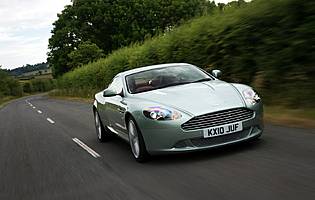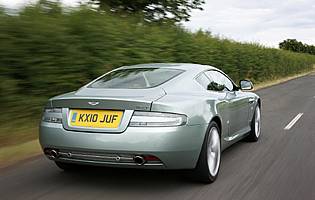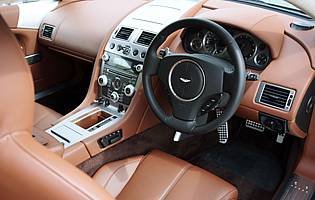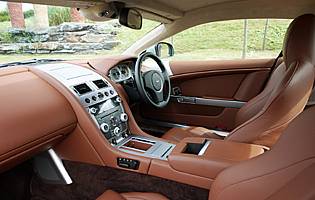



Overall rating
![]()
Subtle changes mark out the revised DB9




![]()
One of the key cars in the Aston Martin renaissance has been the DB9, occupying the upper reaches of the luxury GT market and bringing many new buyers into the brand. It is also the oldest design in the existing range having first appeared in 2004, and so to keep pace with newer rivals the DB9 has been refreshed inside and out.
Few cars at any price can match the visual drama of the DB9. Its exterior design is an impressive blend of classic Aston Martin details but with a thoroughly modern feel. The updates to the exterior are modest and merely give the looks a lift rather than change them dramatically. The most obvious change is the front bumper and grille arrangement which are smoother and have bright-finished mesh. Standard 20-inch alloy wheels with a diamond-turned finish also catch the eye.
Underneath the skin, the DB9 uses the same complex architecture as before. The core of the car is constructed entirely from aluminium, using high-tech bonding rather than riveting for lightness and strength. The bodyshell is also a mix of aluminium and composite panels, which brings exceptional strength and light weight.
Mechanically, the DB9 retains the desirable front-engined and rear-wheel drive layout with the engine mounted almost completely behind the front axle and the gearbox rear-mounted to achieve the perfect 50:50 front/rear weight distribution. The 6.0-litre V12 engine is designed to offer a more relaxed driving style as well as impressive performance, and retains the same huge performance reserves as before.
However, the biggest change to the DB9 is with the suspension as it adopts the Adaptive Damping System already used to good effect on the DBS. By electronically controlling the actions of the dampers, the driver can alter the characteristics of the car by simply pushing a button. The two modes available are Normal and Sport, with the car defaulting to Normal when started.
Aston Martin has made a few detailed changes to the DB9 as that is all that is required: it was already a magnificent example of the Grand Tourer, but the adaptive suspension means it can be further tailored to suit the road conditions and the driver's mood. It remains expensive to purchase and run, but it is also still a car to be savoured and enjoyed.
Running costs for the DB9 will be very high indeed. The purchase price, fuel consumption and insurance are all at the top end of the scale, making it a car for the well-heeled only.
The DB9 is relatively restricted in terms of space, particularly given its size, although most importantly front seat passengers are well catered for. Rear seat occupants will not be comfortable on longer journeys.
The layout of the DB9 is classy and attractive, with fine materials, subtle lighting and plenty of equipment. The actual ergonomics are a little less successful though, and navigating around the various systems can take a little time. The displays are very attractive however, particularly the floodlit instruments.
The ride, although relatively firm, copes well with lumps and bumps thanks to the strong architecture, although in Sport mode there is an inevitable reduction in compliance. Road and wind noise is well disguised and at a cruise the engine settles down to a discreet rumble. The seats are also very good, with full electric adjustment to attain an excellent driving position. The rear seats are somewhat lacking in comfort however, although they are designed for occasional use.
Befitting a car of this price and exclusivity, the DB9 comes with an alarm and immobiliser as standard. This can be upgraded to include a tilt and intrusion sensor, while a tracking device is also on the options list.
With an immensely strong chassis the DB9 offers a high level of passive safety, while the high performance brakes and suspension, combined with a standard stability control system, promise an equally high level of active safety.
Time has not dimmed the driving pleasure that the DB9 can offer, and the mix of the potent and sonorous V12 engine with the composed chassis results in satisfaction regardless of the road conditions. With the suspension in normal mode the handling is keen but is not disturbed by road imperfections - if the road is smooth and requires extra stiffness then the Sport button can be pushed, and any hint of body roll is eliminated.
The DB9's family appeal is limited by its small rear seats. Only the smallest child seats will fit and the boot is insufficient to carry large amounts of luggage.
Although all sorts of drivers will find the DB9 appealing, it is too expensive and powerful for a new driver.
The DB9 is right at the top of the quality tree, with clear attention to detail and high quality materials throughout. The end result is a car that is a pleasure to operate, right down to switches on the dashboard or opening the boot. The same can be said for the DB9's image, which is close to peerless. The combination of a famous back catalogue of fine performance cars alongside a successful racing heritage and cinematic appearances make it one of the most desirable cars money can buy.
A svelte coupe of this height should be difficult to get into but the clever arrangement of the doors, which open out and upwards, makes getting into the front surprisingly easy. Rear seat passengers do have to squeeze a little even though the front seats slide forward. Access to the boot is adequate, although the aperture is relatively modest.
All DB9 models are fitted with a premium audio system as standard with a powerful 700W amplifier and a dedicated iPod connector. Steering wheel controls allow easy operation and the sound quality is exceptional regardless of the input device. A further upgrade is available to a superb Bang and Olufsen system with acoustic lenses for greater control of the sound.
The DB9's cabin can be customised to a large degree with a choice of wood or metal finishes to the dashboard. In any configuration it is a highly attractive layout, with quality materials and first class construction. An increased range of colours have been provided as a part of the latest revisions.
Given its low slung driving position and lack of conventional bumpers, parking the DB9 can be a little taxing. The clutch is also quite heavy, which can make low speeds difficult to maintain. However, the light steering and standard rear parking sensors do help.
Tyre inflation system fitted as standard, with tyre pressure monitoring.
Petrol engine: 6.0-litre (470bhp and 510bhp). Transmission options: Six-speed manual or six-speed Touchtronic automatic.
Bentley Continental GT Impressive blend of performance and comfort
Mercedes-Benz CL-Class CL63 AMG is technically impressive but lacks involvement
BMW 6 Series M6 boasts superb performance, styling not to all tastes
Audi R8 Brilliant to drive and flawless cabin